On Wednesday afternoon, two days after Typhoon Nari had flooded major
streets and more than 3,000 basements in eastern Taipei, employees of the Hello Kitty store on Chunghsiao East Road were hawking sodden Kitty and Post Pet dolls from a makeshift stand in front of their former store. Located in B1, their shop had been completely submerged by Nari's record rains just a day and a half before.
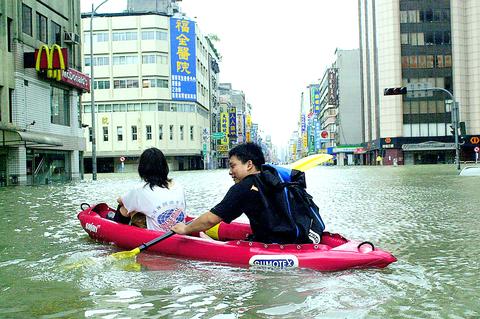
PHOTO: LU CHUN, TAIPEI TIMES
A little water, however, could neither dampen the appeal of Asia's most marketable icon nor the proprietor's entrepreneurial spirit. Shouts of "A hundred each!" and "Fifty each!" attracted a small crowd around the pile of salvaged trinkets and soggy stuffed animals. Bargain prices also helped.
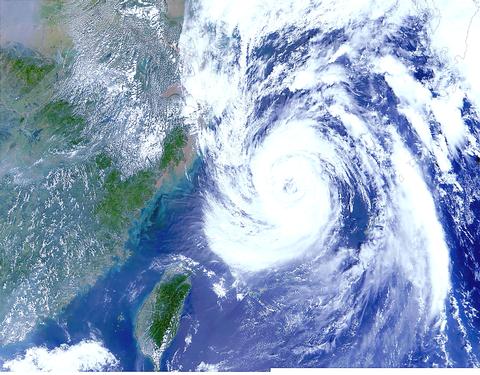
PHOTO: AFP
"Everything in the store is ruined," said Lin Pai-tsong (
Northern Taiwan has been ravaged by typhoons before, but it has not seen rains like those dropped by Nari in its 71 years of recorded weather history. Taiwan's Central Weather Bureau announced that last Monday the storm dropped a record 425mm of rain in a single day at its offices near the Presidential Office, and dropped as much as a full meter of rain in other parts of Taipei, like Yangmingshan and Nankang.
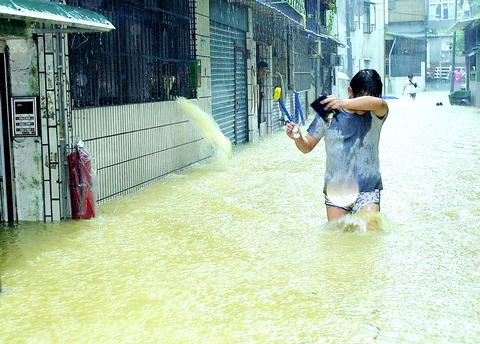
PHOTO: CHIANG YING-YING, TAIPEI TIMES
On average, Taipei receives 2.1m of rain a year and Yangmingshan, as measured by the weather station at Chuzihu, records an average rainfall of 4.5m each year. So, in a single day, northern Taiwan got between one fourth and one fifth of its average annual precipitation.
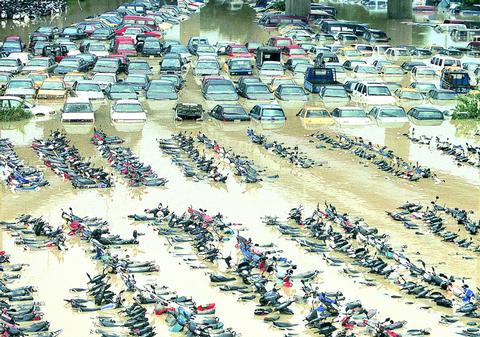
PHOTO: AP
"This has never happened before. The water all came down in the blink of an eye," said the store manager of the Wellcome supermarket that shares its basement with the Hello Kitty boutique. Unlike Hello Kitty, however, Wellcome's inventory of food was almost completely unsalvageable.
"We tried to save some things [on Monday morning] until people received electric shocks while in the water, then we just got out of there and left everything to soak," he said.
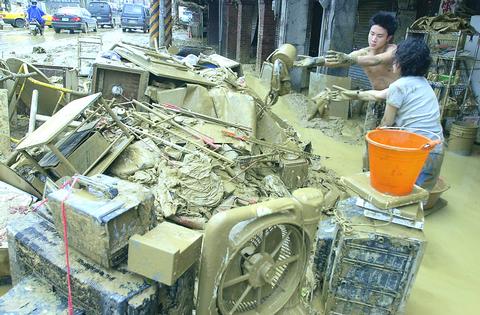
PHOTO: LIAO RUEY-HSIANG, TAIPEI TIMES
Despite the loss, however, he is not overly distressed. "We were going to renovate anyway. The flood will just accelerate our schedule."
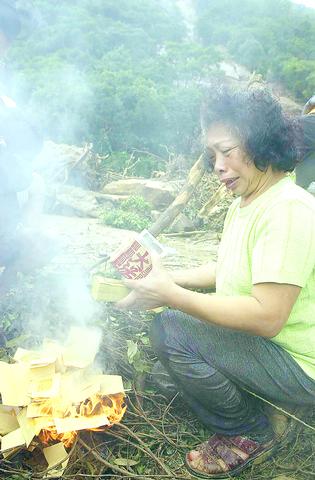
PHOTO: CHIANG YING-YING, TAIPEI TIMES
A few hundred meters down the street, a representative for the Sogo department store, one of the retailers hit hardest by the storm, was similarly upbeat. "It's not really that serious," said store spokeswoman Ting Li-chen (
New York New York, a department store in the Hsinyi District, estimated its damages at over NT$100 million.
Like Sogo, New York New York saw three underground levels flooded, including a food court and a two-level parking garage. Airing waterlogged furniture on adjoining plazas, the complex had opened its above-ground levels by Friday while still pumping water from its basement.
Sogo, however, was still closed yesterday except for a small perfume concession at the building's entrance.
The flooding which would damage these and many other Taipei businesses began early Monday when Nari's deluge began pushing Taipei City and Taipei County water systems to the brink. Failures occurred at eight of Taipei's 69 pumping stations and two of Taipei County's 29. When working properly, pumping stations drain sewers by pumping excess water into streams and rivers.
Among the stations that failed was the Yucheng pumping station, which the government has touted as Asia's largest and most advanced. Yucheng handles water flow from commercial and residential areas that cover 1600 hectares of eastern Taipei, including parts of the Ta An, Sungshan, Hsinyi and Nankang districts.
Designed to pump 184m3 of water per second, which roughly translates into 45mm of rainfall per hour, Yucheng's seven pumps were confronted with rainfall of more than 80mm per hour for several consecutive hours early Monday morning. The overload caused pump failures and forced drain water back into the streets.
Some of the worst damage was to cars. According to one estimate, over 100,000 vehicles were damaged in the floods in Taipei City and Taipei County. Repair costs for cars damaged in the floods can range from NT$8,000 for a rain-soaked carpet in a cheap car to over NT$1 million to restore a completely submerged Mercedes.
Danger zone
Central Taipei got a taste of flooding that is usually reserved for communities with inadequate water management facilities, like Hsichih and Mucha. Of course, those places flooded too -- as did sections of nearly every county in Taiwan.
In Mucha along Mucha Road's Section 4, water from the rising Chingmei River began lapping at the door of Chou Song-chi's
"I guess they were happy about the typhoon," he said, only half-jokingly, knowing that most were salt-water fish and would die anyway.
Across the street from Chou's store is a retaining wall about 1.5m high. On the wall's opposite side is a sharp 5m drop to a newly refurbished park along the bank of the Chingmei River, which flows through a concrete sluice. The river is normally so shallow one could wade across without getting any deeper than knee level. So it would seem that the effects in Mucha of Nari's downpour, which brought what is normally a stream out of its sluice, over a 5m retaining wall and into Mucha Road, should be as unprecedented as the flooding at Sogo.
Well, almost. The Chingmei River wreaked virtually the same damage last year during Typhoon Xangsane on the small area at the corner of Wanshou Road and Mucha Road. The neighborhood consists only of two narrow lanes containing two rows of three-story buildings, and many of its residents are distressed by the channel's unusual recent history of floods.
"I'm angry. But what can you do?" said a man surnamed Peng, a professor at Chengchi University. "The dikes aren't high enough and instead of making them higher, the city government builds basketball courts in that park that have to be remade every year when the river floods."
Peng was in the process of moving to a flood-safe home before Nari hit, but had not yet transported his extensive stash of books, many of which were ruined despite being stacked on the apartment's second floor. "After the flood last year I decided to move before it happened again. But it looks like I was just a couple weeks too slow," he said.
Moving on
Those in the neighborhood who were renting homes are now eager to move, but other residents who own their homes, like Peng, have no choice but to grin and bear it.
Apartment owner Chen Chiu-nan (
TV news coverage during Nari, in fact, showed a family being rescued by dinghy from his apartment block's second-floor balcony -- hardly a good sales pitch for area homes.
On Wednesday once the typhoon had passed, frustration mixed into the banter of many Mucha locals, who waded through rancid, ankle-deep mud as they piled up damaged household items like TVs, refrigerators, furniture and potted plants.
At the same time, similar piles of flood-spoiled objects formed along numerous thoroughfares in eastern Taipei. But while assessing the damage and sweeping up the mud, central Taipei residents took a more ho-hum attitude toward their work.
"It was a natural disaster and there was no way to prevent it," said Lin Shao-jen

June 2 to June 8 Taiwan’s woodcutters believe that if they see even one speck of red in their cooked rice, no matter how small, an accident is going to happen. Peng Chin-tian (彭錦田) swears that this has proven to be true at every stop during his decades-long career in the logging industry. Along with mining, timber harvesting was once considered the most dangerous profession in Taiwan. Not only were mishaps common during all stages of processing, it was difficult to transport the injured to get medical treatment. Many died during the arduous journey. Peng recounts some of his accidents in

“Why does Taiwan identity decline?”a group of researchers lead by University of Nevada political scientist Austin Wang (王宏恩) asked in a recent paper. After all, it is not difficult to explain the rise in Taiwanese identity after the early 1990s. But no model predicted its decline during the 2016-2018 period, they say. After testing various alternative explanations, Wang et al argue that the fall-off in Taiwanese identity during that period is related to voter hedging based on the performance of the Democratic Progressive Party (DPP). Since the DPP is perceived as the guardian of Taiwan identity, when it performs well,

A short walk beneath the dense Amazon canopy, the forest abruptly opens up. Fallen logs are rotting, the trees grow sparser and the temperature rises in places sunlight hits the ground. This is what 24 years of severe drought looks like in the world’s largest rainforest. But this patch of degraded forest, about the size of a soccer field, is a scientific experiment. Launched in 2000 by Brazilian and British scientists, Esecaflor — short for “Forest Drought Study Project” in Portuguese — set out to simulate a future in which the changing climate could deplete the Amazon of rainfall. It is

The Taiwan People’s Party (TPP) on May 18 held a rally in Taichung to mark the anniversary of President William Lai’s (賴清德) inauguration on May 20. The title of the rally could be loosely translated to “May 18 recall fraudulent goods” (518退貨ㄌㄨㄚˋ!). Unlike in English, where the terms are the same, “recall” (退貨) in this context refers to product recalls due to damaged, defective or fraudulent merchandise, not the political recalls (罷免) currently dominating the headlines. I attended the rally to determine if the impression was correct that the TPP under party Chairman Huang Kuo-Chang (黃國昌) had little of a